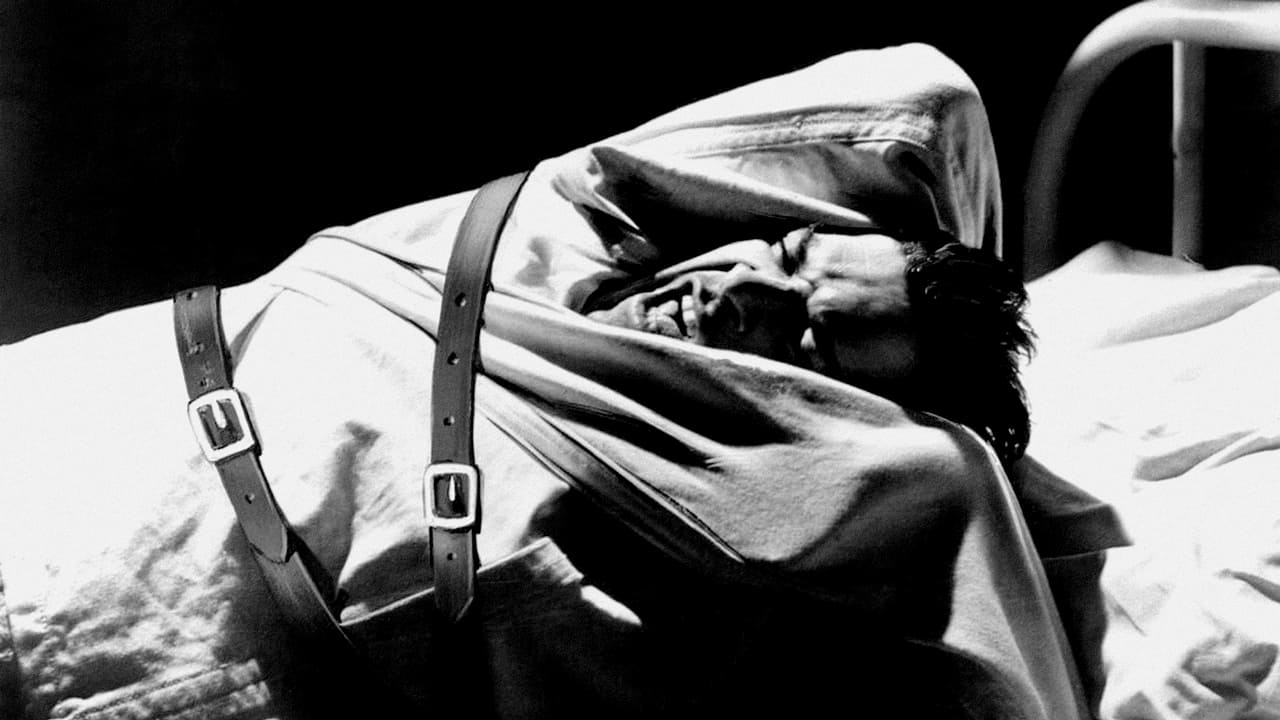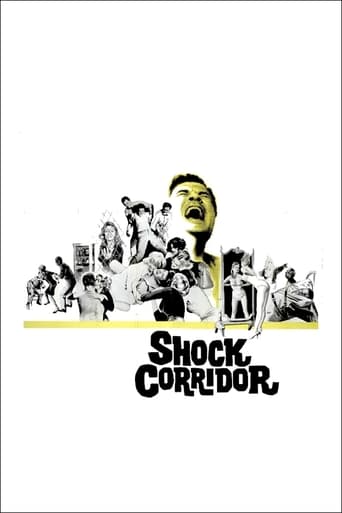Inadvands
Boring, over-political, tech fuzed mess
Comwayon
A Disappointing Continuation
Borgarkeri
A bit overrated, but still an amazing film
ChampDavSlim
The acting is good, and the firecracker script has some excellent ideas.
zardoz-13
"Naked Kiss" writer & director Sam Fuller's stark melodrama about a single-minded newspaper journalist who poses as a mental patient to expose a murderer is unforgettable. Mind you, you may experience a little Catatonic schizophrenia after watching this gripping mystery thriller. Reportedly, Fuller lensed "Shock Corridor" in ten days, and he plunges us into a psycho ward and all the ways that modern medicine had of helping the unhinged. The gallery of unusual characters that our protagonist encounters in this 101 minute masterpiece is stunning in its diversity. The cast is good, especially James Best of "Dukes of Hazzard" fame. Foremost, the African-American inmate (Hari Rhodes) who believes that he belongs to the Klu Kux Klan is truly memorable. The first time that we see him, he is carrying around a protest sign with the N-word on it. Undoubtedly, this was a controversial role to take at the time. You can see a laundry list of social ills as well as issues addressed in this opus. Ultimately, the beauty of this film lies in its utter simplicity. The surprise ending is the stuff that genuine horror chillers are made, but savvy viewers may be a step ahead of Fuller as he weaves his intricate tale with lots of symbolism and commentary to its inevitable conclusion. Aside from an office at a newspaper and back stage at a burlesque theater, "Shock Corridor" takes place entirely in a mental ward, primarily on the so-called 'street' or shock corridor where the patients hang out during the day when they are not confined to their rooms. Presumably, Fuller pared down the production budget to absolute essentials and the film has a bare-bones, efficient look. Nothing about "Shock Corridor" is remotely glamorous. This isn't an easy film to watch because it is so brutal. Of course, although it was produced back in 1963, the film still manages to pack a wallop.Newspaper reporter Johnny Barrett (Peter Breck of ABC-TV's "The Big Valley") wants desperately to win a Pulitzer Prize, and he convinces everybody including his newspaper editor than he can masquerade as a nut-job and uncover the killer that the police could not find. Johnny's beautiful stripper girlfriend, Cathy (Constance Towers of "The Horse Soldiers"), is against the scheme. She doesn't like it because she thinks that Johnny will lose his mind while he is in the facility. Sure enough, nobody listens to her. Meanwhile, against her better judgment, she cooperates with Johnny and the newspaper. She informs the authorities that she is really Johnny's sister and that he has been harassing him about sex. Once the medical experts get their hands on Johnny, he has to survive only the electro-shock therapy that they dole out to him but also the loonies in the ward. Johnny struggles daily to extract the information from his fellow inmates. At one point, no doubt to give the picture dimension, Fuller stages an assault in the nympho ward where our hero tries to escape and finds himself mobbed by a group of desperate dames. Primarily, Johnny associates as possible with the patients who were present in the room when the other patient was killed."Shock Corridor" is unrelenting stuff! The irony is evident throughout.
ofpsmith
Shock Corridor is a film that Samuel Fuller made with limited sets and a tight budget. But out of these limitations Fuller made a truly great film. Yeah it's cheesy in some parts and some of the acting is pretty bad but it's a film that really get's under your skin. Johnny Barrett (Peter Breck) is a reporter for the paper who has himself committed to a mental hospital to solve a murder. I think this would actually be illegal but so on. Whilst there, Barrett befriends three main patients. Stuart (James Best) an ex soldier who underwent North Korean brainwashing, defected and returned and now believes himself to be General JEB Stuart of the American Civil War. Trent (Hari Rhodes) is an African American college student who was one of the first African Americans to integrate a Southern University, but was broken by racism and now believes himself to be a member of the Ku Klux Klan. Boden (Gene Evans) was a brilliant scientist who was driven insane by the knowledge of nuclear weapons and now has the mental capacity of a six year old. Martin Scorsese said that Stuart, Trent, and Boden represent the insanities of war, racism, and nuclear weapons respectively and I think that that's what Fuller's intentions were. Scorsese also pointed out that Fuller was showcasing in these characters that the United States had become like an insane asylum. I recommend Shock Corridor though I must point out. It is not for the faint hearted.
mark.waltz
What some people won't give up to get the big story. When that story involves murder, it can lead to madness. This film gives the tagline, "Whom God intends to destroy, he first drives mad". I am not sure I agree with that analogy, but some being is definitely out to drive reporter Peter Breck mad as well as the sad creatures he ends up surrounded by when he enters a mental institution to discover the truth about this unsolved crime. This is the type of film that at times appears to be one giant metaphor, and in the case of this low-budget psychological thriller that took film noir into a new direction, that metaphor leaves you with a lot of head scratching. In spite of all that, you can't take your eyes off of the screen.For example, just what is the relationship between Breck and the beautiful exotic dancer (Constance Towers) who may or may not be his sister? He claims to psychiatrist Phillip Ahn that they are indeed siblings, but their relationship is definitely not brother and sisterly. Enough clues are revealed to tell the truth, but the fact that this key plot point was utilized in the first place puts a rather creepy feeling into the story.This was a change of pace for the gorgeous Ms. Towers who had played only corseted heroines and was moving into the Broadway musical stage at this point. To see the very sophisticated Mrs. John Gavin in almost next to nothing is shocking in itself, especially if you first remember her, as I did, as the sweet Clarissa McCandless on the daytime soap "Capitol". Of course, I went into complete shock years after that when she began her long-running role as the throat-slicing Helena Cassadine on "General Hospital", so this shows how, as a young actress, she wanted to explore a variety of parts, no matter how racy or crazy the characters were. See her other Samuel Fuller directed film noir, the steamy "The Naked Kiss" for another side of this gorgeous lady.While the plot takes a while to unfold, it is filled with details of the various types of characters one might encounter in an old fashioned mental institution. Most shocking is the grossly overweight killer who can't get enough to eat, and somewhat controversial is the black patient who has somehow come to believe that he is white and a supremacist to boot. When the black patient starts a chase of another black inmate, obviously planning a lynching, you might find yourself open-mouthed in shock because it truly is unbelievable.This isn't a film that I think I could watch over and over again. It is definitely extremely spooky to watch, and in this day and age where mental institutions pretty much no longer exist (except for the criminally insane), it makes you look at how times haven't helped people with mental issues, only left them lacking in the type of care they need. Of course, we'll never be back to the type of institutions which film audiences got to explore through "Bedlam", "The Snake Pit" and "The Caretakers" (although this one makes those films look tame in comparison), but these films remind us of how our society has gone from one extreme to another where nothing is done, even if the evil of past treatments no longer exist as well.
seymourblack-1
Samuel Fuller's experience as a crime reporter and pulp novelist are very evident in his work as the writer, director and producer of "Shock Corridor". This is a movie which makes a big impact, primarily because of its outrageous plot but also because of its lurid content and its powerful social commentary. Fuller's tabloid sensibilities are clearly intact as he adopts a bold and uncompromising style to deliver the story and his observations about some of the issues which were preoccupying society in the early 1960s.The publicity for the movie was overtly sensationalist and promised its audience a story containing sex, violence, psychos, schizos and men in white coats (one of whom was having sexual relationships with the female patients). Additionally, the central character is seen being straight-jacketed, being given electric shock therapy and being attacked by a group of nymphomaniacs.Fuller clearly has little time for subtlety and this fits perfectly with the needs of a maker of low budget movies and provides his output with a tremendous amount of vibrancy and energy. "Shock Corridor" is ostensibly a murder mystery but the events that take place in trying to solve this particular crime soon take prominence over everything else.Johnny Barrett (Peter Breck) is an ambitious newspaper reporter who's determined to win the Pulitzer Prize and decides to do this by getting himself into a mental hospital as a patient so that he can carry out his own investigation into the unsolved murder of one of the inmates. In order to do this, he's helped by a psychiatrist called Dr Fong (Philip Ahn) who teaches him how to appear sufficiently unstable to be committed to the institution and also his editor "Swanee" Swanson (Bill Zuckert). These two men are enthusiastic conspirators but Johnny's girlfriend Cathy (Constance Towers) who's a stripper and a singer is far more reluctant to be involved.Cathy, however, is soon persuaded to co-operate and posing as Johnny's sister makes the charge that he'd tried to sexually assault her. This leads to Johnny being committed as planned and also to him being able to begin his investigation. There were three inmates who'd witnessed the murder and Johnny's challenge is to get to the truth of what happened by eliciting the pertinent information from these witnesses before his own mental state suffers irreparable damage.Peter Breck effectively portrays the aggression and single mindedness of Johnny Barrett who was desperate for recognition and the prestige of being a Pulitzer Prize winner. His determination to achieve this goal was commendable but the means by which he planned to do so was fraught with a level of danger which Johnny ignored because he was supremely confident that his own sanity wouldn't be threatened by being institutionalised. This error of judgement predictably meant that any success that he achieved came at a very high price.The three witnesses that Johnny conversed with all displayed bizarre behaviour and were all victims of traumas that were strongly linked to social issues of the period (i.e. the arms race, racism and anti-communism). Fuller's use of the quotation "Whom God wishes to destroy, he first makes mad" (Euripides) is interesting as it clearly refers to the predicaments of the patients in the asylum but also infers that as their problems were triggered by manifestations of society's madness, it's not only the patients who stand to be destroyed.

